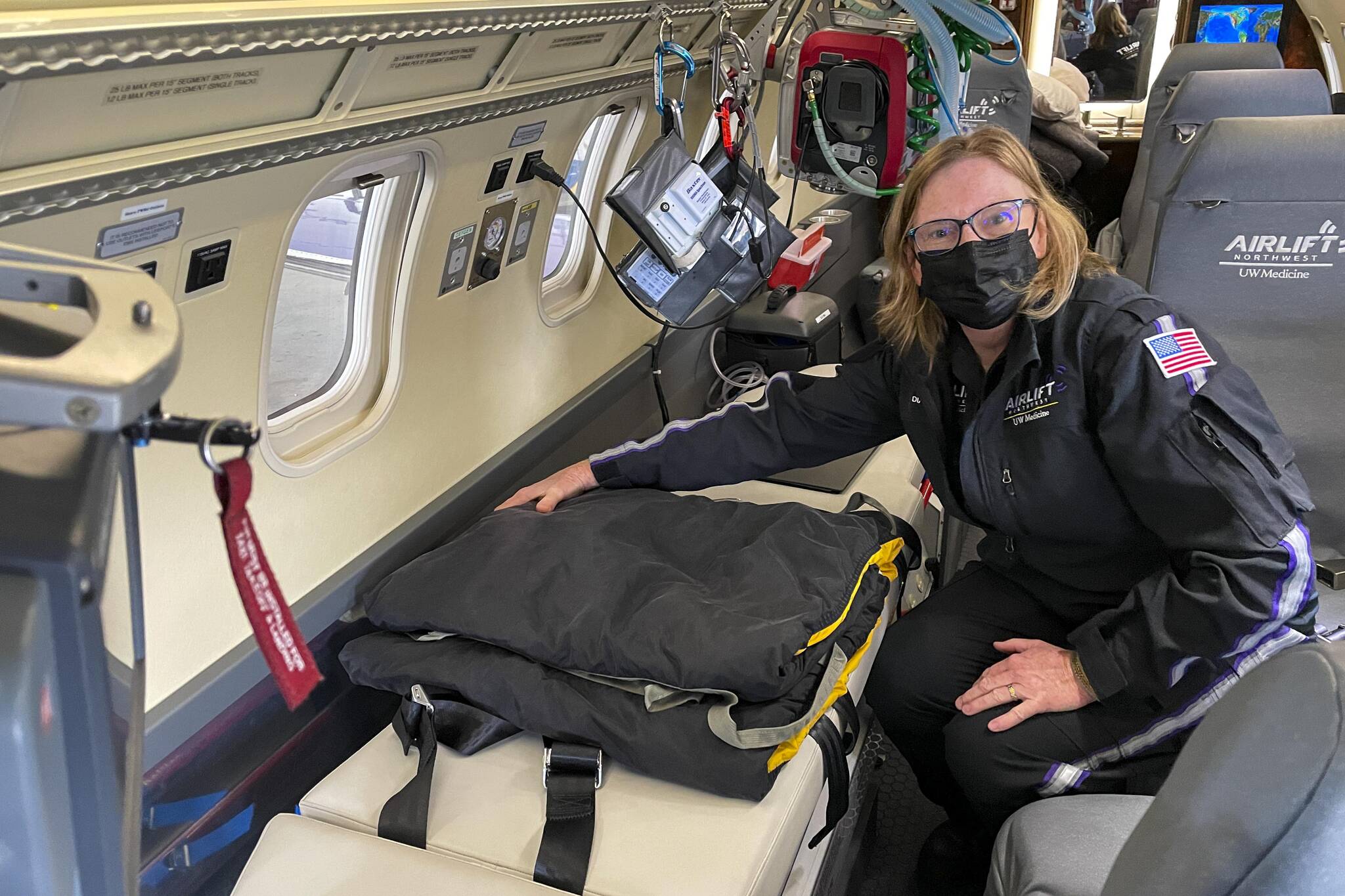Speed is life for serious injuries: getting a casualty to the care they require can determine the fate of a severely injured person.
And a Learjet 45 XR (extended range) stationed in Juneau will aid Airlift Northwest in doing just that.
“I love it. There’s a lot more room,” said Diana Paul, a flight nurse with Airlift Northwest in an interview. “It flies very stable and smooth.”
The aircraft arrived in Juneau about a month ago, said Shelly Deering, the manager for the Alaska station. The new 45XR replaces an older Learjet model that the organization flew, the Learjet 31A. While both aircraft had their interior rebuilt for medevac capability, the 45XR has longer range and is slightly larger, allowing for better care inside and the ability to make the Anchorage to Seattle trip in one hop without requiring refueling, Deering said.
“They’re medically configured to make it optimal for nurses to work with the patients,” Deering said. “Its drawers and cabinets are in place for access to stuff you might need. There’s mounting systems for monitors and ventilators.”
On the inside, the aircraft has clearly gone through a metamorphosis from its beginning. The seats on the starboard side of the cabin have been removed to make room for the stretcher, which is now easier to bring aboard, Paul said. Rails run on the ceiling to hold things like monitors, IV pumps, and other medical hardware to stabilize casualties as they’re transported to higher care facilities. Two nurses are onboard each flight to cover different areas of responsibility, Paul said.
“You have what you need close. And it makes things secure so it’s safe for both the nurse and the patient,” Deering said. “If we hit turbulence, they’re not going to get hurt.”
In the distant past, practice was to strap the stretcher across a row of seats in a commercial flight while a medical professional rode with and took care of the casualty, Deering said. Northwest Airlift was the idea of Dr. Michael Copass, a doctor for the University of Washington Medicine system, who created it about 40 years ago. Copass was visiting Sitka when a house fire brutally burned three children; all three died as a result of their wounds, with medical personnel unable to medevac them to a higher-order burn unit.
The aircraft also have more modern avionics than their predecessors, said pilot-in-command Robert Wells. The 45XR is a big improvement over the earlier models, Well said, with improved ease of use and situational awareness, which is critical in the Southeast’s brutal mountains and tempestuous weather.
“We did a Kenai-to-Seattle the other night. Before we would definitely have to stop to refuel. That’s one of the biggest improvements,” Wells said. “Around here, especially with the terrain, to have more awareness is always an improvement.”
AN is a part of the UW health care system, Deering said, which supports them and gives them a healthcare system to work with, which can expedite care, as well as providing support for things like on-station blood products, which can be difficult to get without connection to a larger healthcare organization. Aero Air LLC is contracted to provide the aircraft, flight crews, and maintenance personnel for AN’s operations in all of its regions of operation.
“Before COVID, we did almost a flight a day,” Deering said. “COVID decreased those numbers but we’re starting to see those numbers pick up again.”
As those numbers bounce back, Airlift has adjusted to the new reality, Deering said. AN, which operates in Alaska, Idaho, Montana, and Washington, has transported about 800 COVID-19 patients, Deering said.
“These are some of the sickest patients we’ve transported. COVID is a multisystem disease,” Deering said. “When it started, it was a big change. Now we’re used to it.”
Bed availability is now a defining factor in medevac frequencies, Shelly said. Many patients in Anchorage, for example, require a procedure called extracorporeal membrane oxygenation, known as ECMO, which oxygenates blood outside of the body before recirculating, in cases where the lungs are noneffective, Shelly said. Harborview Medical Center is the only Level 1 trauma center in the WAMI area, Deering said. For comparison, Bartlett Regional Hospital is a Level 4 trauma center.
Medevacs aren’t cheap, Deering said- while the operation is a not-for-profit supported by UW, AN is expected to cover their own bills. Medevac flights, between the flat takeoff cost and the per-patient-mile charge, can be between $30,000 and $100,000.
“We’ve combined the two most expensive things: aviation and medicine,” Deering said.
While riding in a flying ambulance is hardly high on anyone’s to-do list, at least AN’s new aircraft will shorten the trip.
• Contact reporter Michael S. Lockett at 757-621-1197 or mlockett@juneauempire.com.

